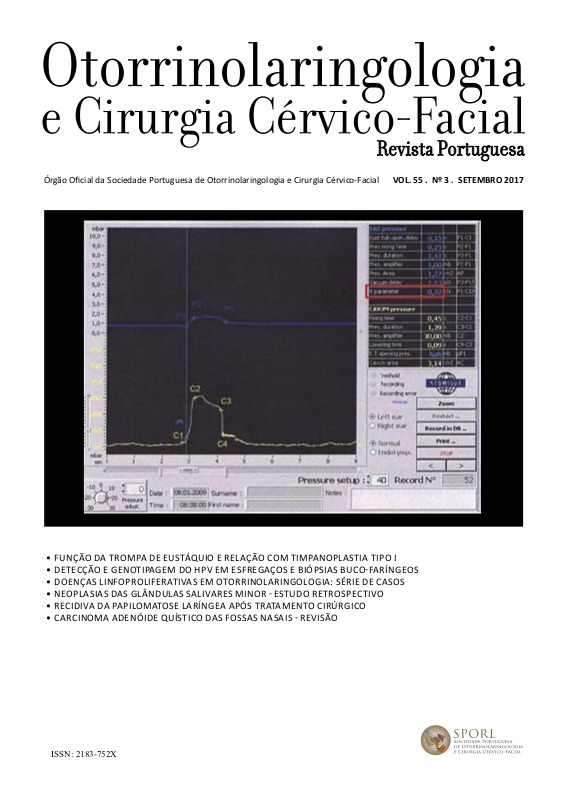Estudo da função da Trompa de Eustáquio e da sua relação com os resultados obtidos após Timpanoplastia tipo I
DOI:
https://doi.org/10.34631/sporl.669Palavras-chave:
Trompa de Eustáquio, tubomanometria, otite média crónica, timpanoplastia tipo IResumo
Objetivo: Estudar a função da Trompa de Eustáquio (TE) e avaliar o seu impacto no sucesso da timpanoplastia tipo I (TTI).
Métodos: Estudo de coorte que incluiu 2 grupos de doentes com Otite Média Crónica Simples (OMCS), recidivada e não recidivada, submetidos a TTI no Hospital de Braga entre Janeiro de 2013 e Agosto de 2015. O estudo da função da TE foi realizado através da tubomanometria (TMM) e o resultado expresso pelo valor R (índice de latência de abertura da TE), relacionando-o com o estado da Membrana Timpânica (MT).
Resultados: A média de R foi 1,4 no subgrupo com recidiva e 0,4 no subgrupo sem recidiva. A diferença inter-grupos do valor de R foi estatisticamente significativa, assim como a relação entre disfunção da TE (DTE) e recidiva da OMCS; χ2(4) = 23.5, p<0, 05
Conclusão: Existe relação estatística entre disfunção da TE e recidiva da OMCS.
Downloads
Referências
- Sade J (1984) Eustachian tube function. Acta Otolaryngol Suppl 414:83–84
- Uchimizu H. Effects of inflammatory changes in the middle ear mucosa on middle ear total pressure. Acta Otolaryngol. 2007
- Poe DS, Gopen Q (2009) Eustachian tube dysfunction. In: Snow JB (ed) Ballenger’s otorhinolaryngology: head and neck surgery. BC Decker, Lewiston, pp 201–208
- Yuceturk AV, Unlu HH, Okumus M, Yildiz T, et al.The evaluation of eustachian tube function in patients with chronic otitis media. Clin Otolaryngol Allied Sci. 1997 Oct;22(5):449-52.
- Di Martino E, Krombach GA, Thaden R, Westhofen M (2004) Function tests for the ET. Current knowledge. HNO 52: 1029–1040
- S. Schroder. Evaluation of tubomanometry as a routine diagnostic tool for chronic obstrutive eustachian tube dysfunction. Official journal of Netherlands Society for Oto-Rhino-Laryngology & Cervico-Facial Surgery 2015
- Seung Choi et al. 2009, Pre-operative evaluation of eustachian tube function using a modified pressure equilibration test is predictive of good postoperative hearing and middle ear aeration in type 1 tympanoplasty patients, Clinical and experimental Otorhinolaryngology, 2009
- Takahashi H, Sato H, Nakamura H, Naito Y, et al. Correlation between middle-ear pressure-regulation functions and outcome of typeI tympanoplasty. Auris Nasus Larynx. 2007 Jun;34(2):173-6.
- Poe DS. Diagnosis and management of the patulous eustachian tube. Otol Neurotol. 2007 Aug;28(5):668-77
- Salviz M, Bayram O, Bayram A, Balikci H, et al. Prognostic factors in type I tympanoplasty. Auris Nasus Larynx. 2015 Feb;42(1):20-3
- Ilana Fukuchi, Tympanoplasty: Surgical results and a comparison of the factors that may interfere in their success. Rev Brasileira, 2006
- Todd NW. There are no accurate tests for eustachian tube function. Arch Otolaryngol Head Neck Surg. 2000 Aug;126(8):1041-2.
- Liu P, Su K, Zhu B, Wu Y, et al. Detection of eustachian tube openings by tubomanometry in adult otitis media with effusion. Eur Arch Otorhinolaryngol. 2016 Oct;273(10):3109-15
- N. Kumar, N. Madkikar, S. Kishve, Devashri Chilke, et al. Using Middle Ear Risk Index and ET Function as Parameters for Predicting the Outcome of Tympanoplasty. Indian J Otolaryngol Head Neck Surg. 2012 Mar; 64(1): 13–16
- N. Kumar, D. Chilke, M. P. Puttewar. Clinical Profile of Tubotympanic CSOM and Its Management With Special Reference to Site and Size of Tympanic Membrane Perforation, Eustachian Tube Function and Three Flap Tympanoplasty. Indian J Otolaryngol Head Neck Surg. 2012 Mar; 64(1): 5–12






